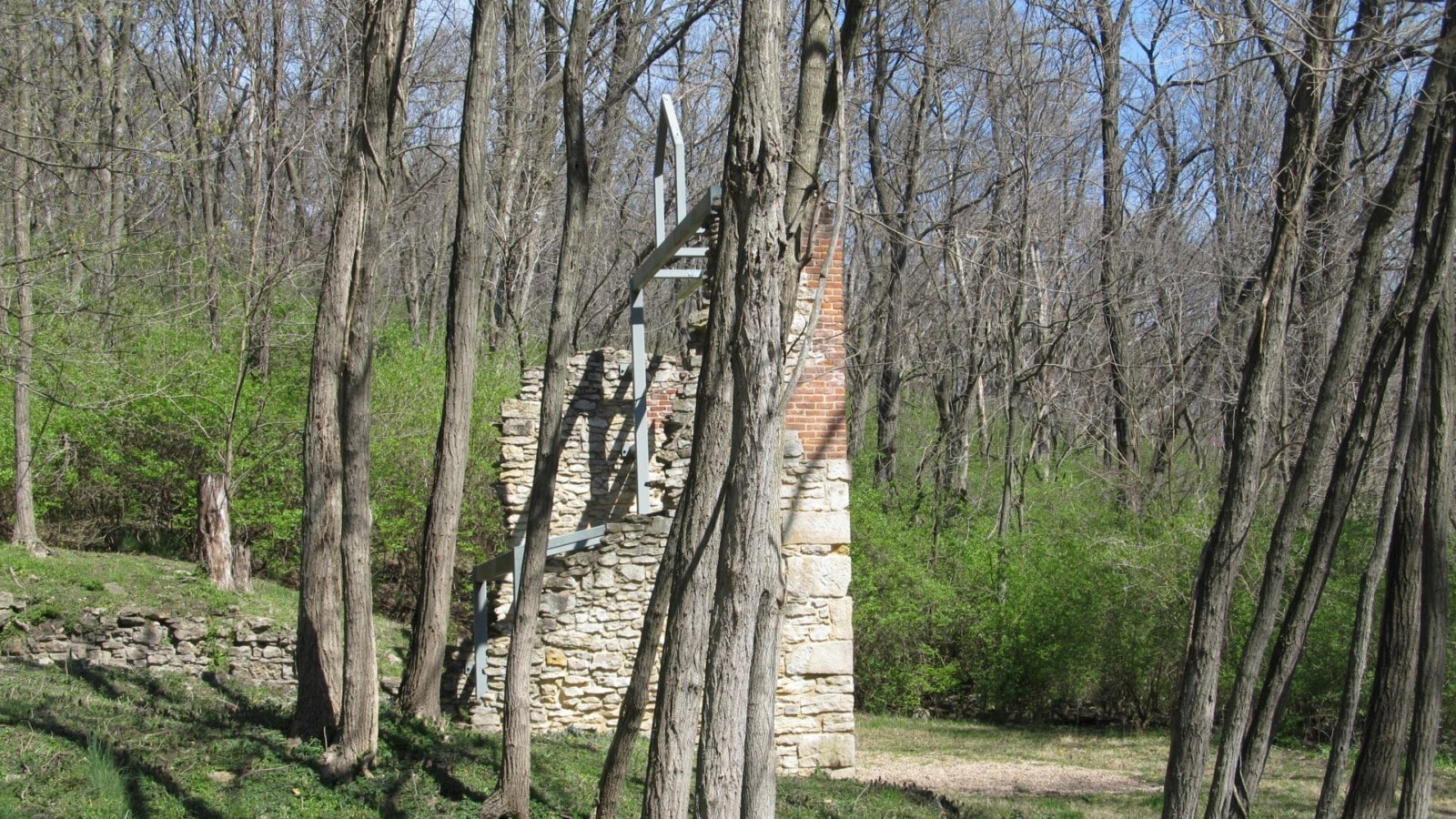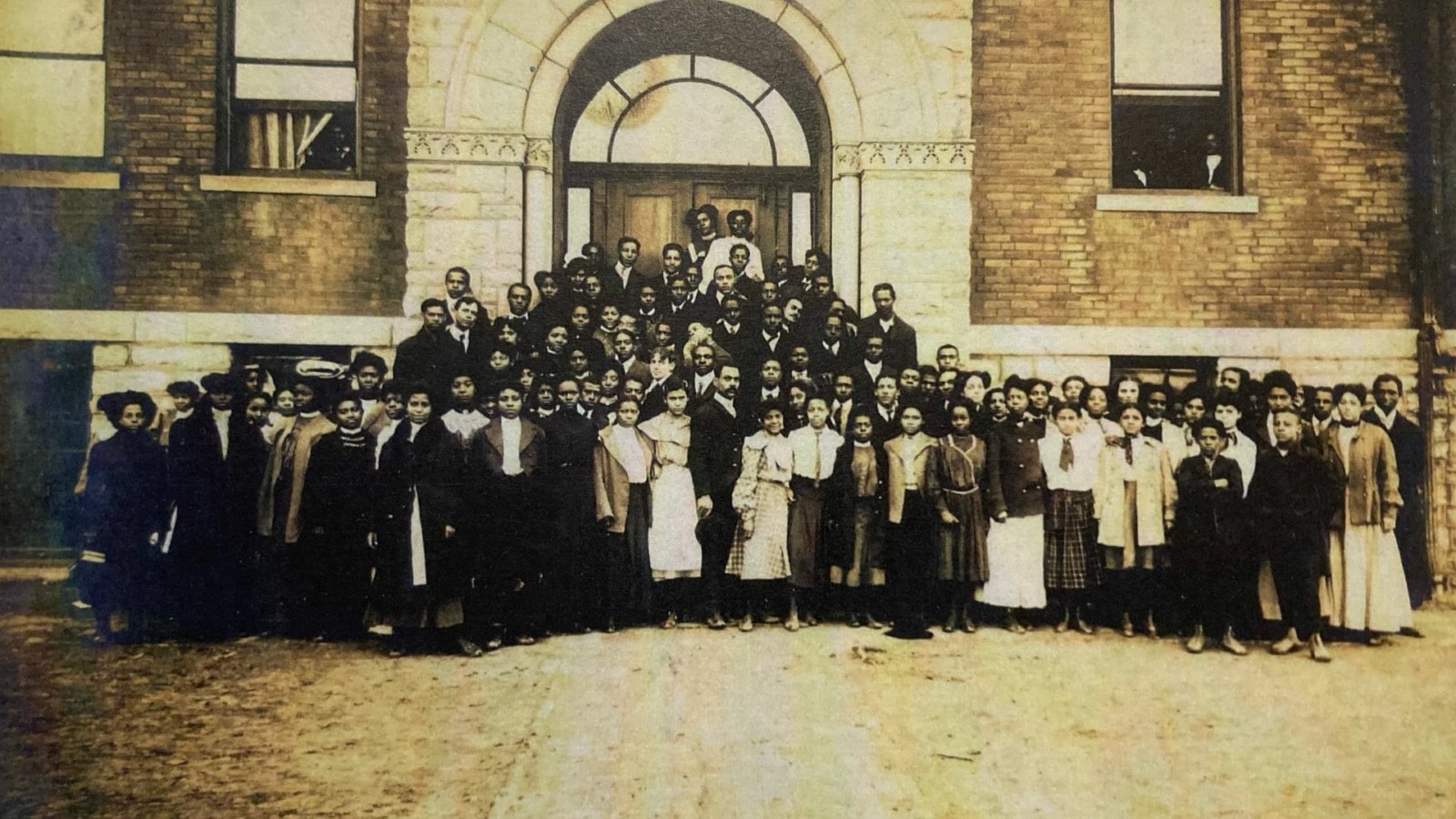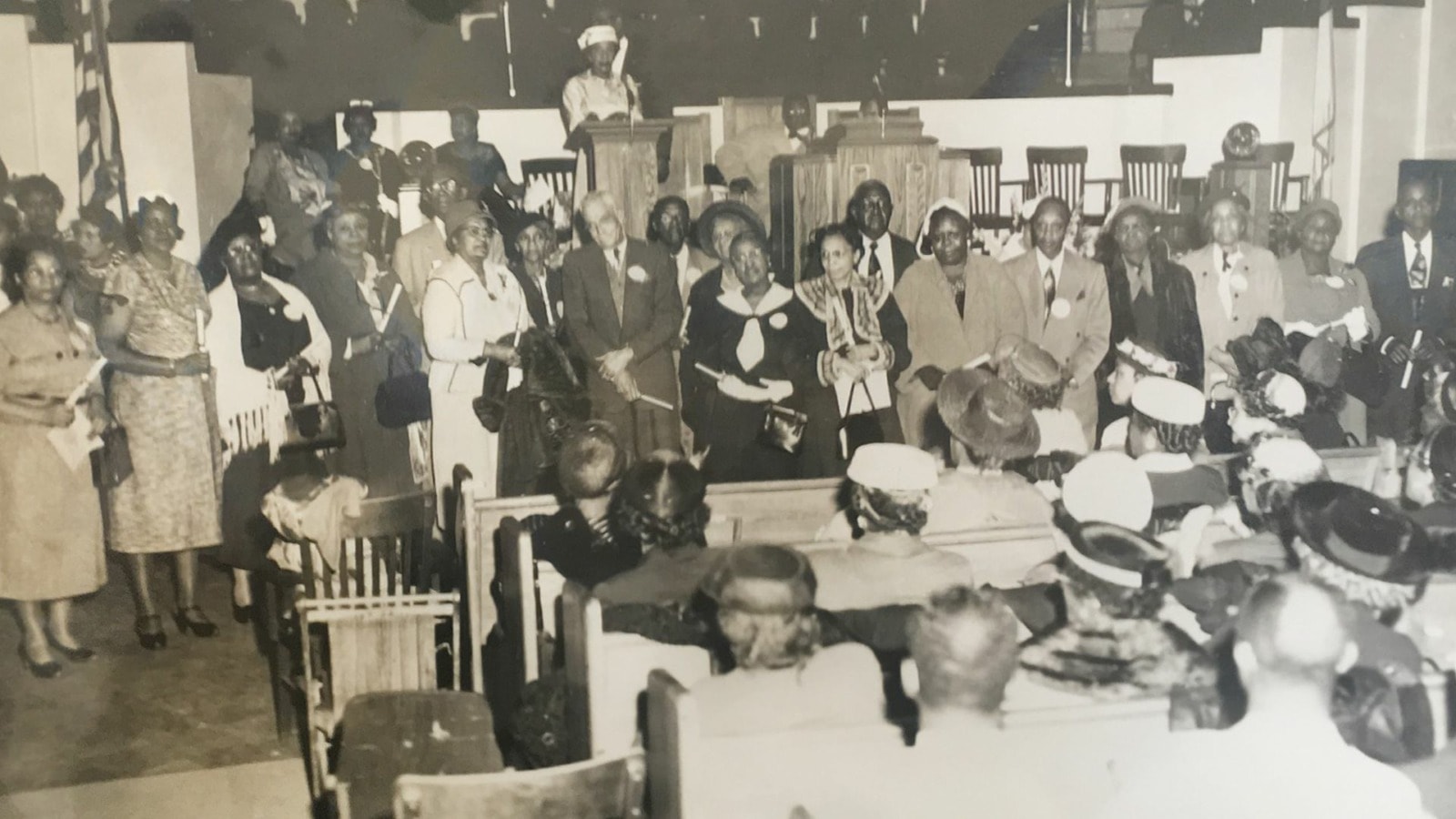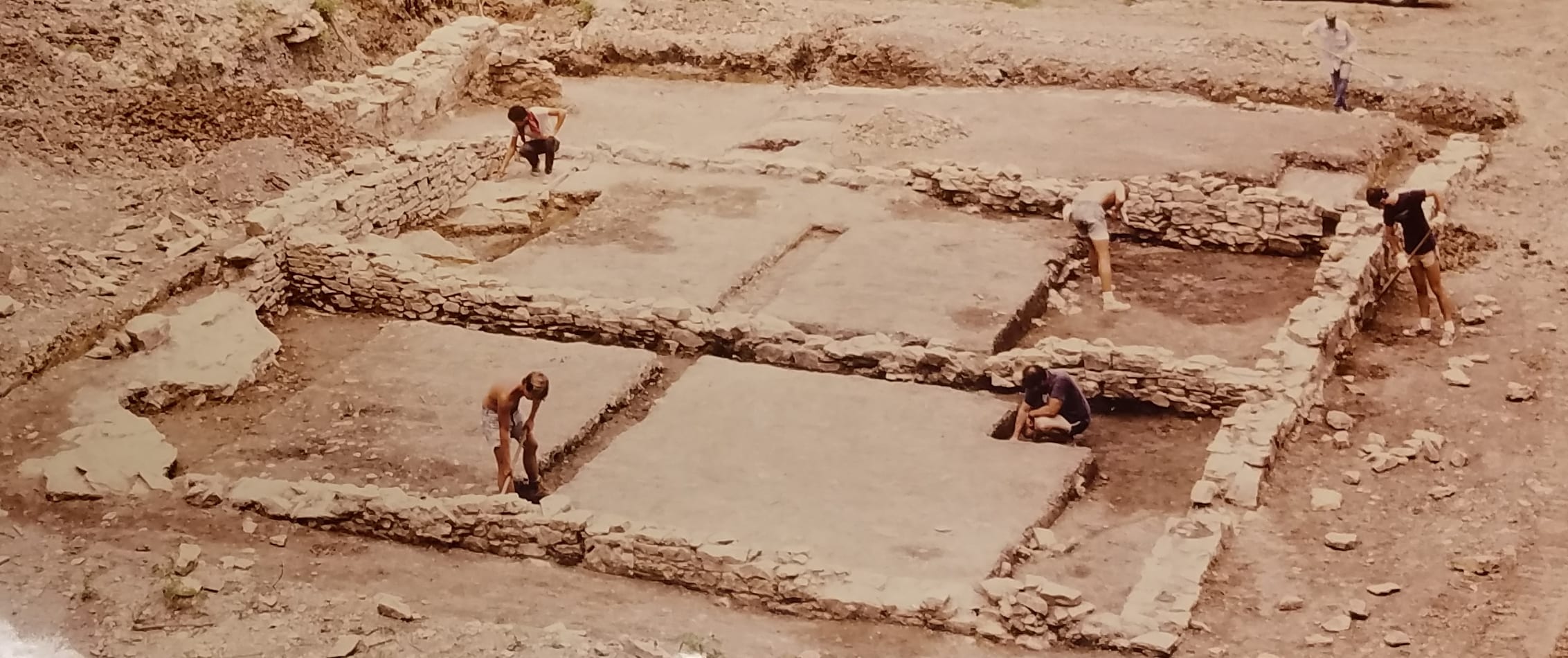Kansas City and the Roots of Black Gospel Music The Untold Story
Published February 8th, 2024 at 6:00 AM
Above image credit: Members of the Whitney Singers performing gospel music in Kansas City. (Courtesy | Electric Prairie Productions)Kansas City is known for its jazz and blues. But the same forces that shaped those American art forms also led to the development of Black gospel music.
The region’s gospel blues has a rich but largely overlooked history. In fact, historians say Black gospel music may be the best window through which to understand the development of the Black community and the churches in and around Kansas City, Missouri, and Kansas City, Kansas.
Gospel music has been a staple of the Kansas City Black church for more than a century. On any given weekend you can find soloists, quartets and choirs sharing their testimony in song. Once you experience Black gospel in a Kansas City church, you don’t forget it: the syncopated rhythms, blues chords, embellished harmonies, the singers’ emotionally charged vocals. A collective spirit of joy spreads through the room.
Gospel music is the expression of gladness that all who put their trust in the Lord will have their burdens lifted. Things may be bad now, but “trouble don’t last always.” This is the promise of the gospel, the good news. The songs sustained a resilient people through bondage, prejudice and discrimination.
“The exclamation point I would put on it is, I think Black gospel in Kansas City proved to be a means of survival for a large portion of the African American population,” says William S. Worley, a Kansas City historian and author.
To be sure, other regions contributed to the gospel sound. But the Kansas City area has its own distinctive story that begins with the African Americans who fled to Kansas, escaping oppression in Missouri and other slave states. Their music was rooted in their African past and shaped by their experiences in bondage, to which they adapted stories from the Bible to create a new folk tradition.
“These were songs of liberation,” says Rev. James Tindall, Bishop Emeritus of the Metropolitan Spiritual Church of Christ. “Gospel music was always liberating.”
Coming Monday on Kansas City PBS
Gospel Roots in Quindaro
The story of gospel music in the Midwest begins in Quindaro, Kansas, on the bluffs high above the Missouri River. This is the site of Western University, founded in 1881 by the African Methodist Episcopal Church in what is now Kansas City, Kansas.
Western University was the first Black college west of the Mississippi River. The school served the children of former slaves and the Exodusters who fled to Kansas from the Jim Crow South in the 1870s. Though it closed in 1943, the legacy of this historic Black school lives on in the major contributions made by its brilliant alumni who would go on to help shape and change the nation’s larger musical culture and entertainment industries.
None of the school’s six buildings – including its music hall, dormitories, vocational shops, livestock barns and gardens – remain. All that is left is a statue of abolitionist John Brown. Erected in 1911, the statue overlooks the ruins of Old Quindaro, the pre-Civil War town that served as a port of entry on the Missouri River for Freestaters and the western edge of the Underground Railroad.
“The statue says to Black Americans, stay on guard. Times are not yet safe,” says Rev. Stacy Evans, former minister at the Allen AME Chapel in Quindaro. “Remain vigilant. Continue to educate yourselves. Continue to work hard.”

Western University blossomed from a seed planted in the early days of Quindaro’s brief existence between 1857 and 1861, the year Kansas became a state. Progressive citizens saw the need to start a school to educate all children, no matter their color. In 1867, the state of Kansas began funding the school, which took the name Freedmen’s School.
In 1880, the school and the surrounding land were deeded over to the AME Church, which changed the name to Western University. The AME church viewed education as the final victory for Black people. “We must educate or be crushed beneath the juggernaut wheels of modern progress,” states minutes from the Sixth Session of the AME Kansas Conference in 1881.
The timing was opportune. More than 40,000 African Americans people swept north into Kansas in 1879. The failure of Reconstruction in the South had thrust them back into subservient roles. Desperate Black people saw Kansas, the home of John Brown, as the Promised Land.
They were called Exodusters, after the Exodus of the Israelites out of Egypt. By 1890, nearly 47,000 Black people lived in Kansas, more than in any other state north of the Mason-Dixon line. They brought their hopes and dreams, and their diverse styles of music.
“So, when the Exodusters started coming in, they had to have brought in just a lot of new material,” says Lemuel Sheppard, a Kansas music historian and blues performer. “New songs. New approaches to music. And they were from everywhere. From all over the South and there was just something about Kansas that was welcoming,”
In her 1927 anthology, “My Spirituals,” Eva Jessye writes about the music embraced by her family and neighbors in Coffeyville, Kansas: “Those who are unfamiliar with the Negro citizenry of southern Kansas may question the authenticity of spirituals gathered from so northern a source. On second thought they will realize that Kansas, and especially the southern section, was the nearest refuge of the runaway slave.”
Western University’s early success was built on the importance and power of music in the lives of Black immigrants. Western’s politically astute President William T. Vernon ascended within the Republican Party and served on the Republican National Committee in 1904. He used his connections to attract gifted music teachers and students to Western.
“And that builds up Western’s music department,” says Deborah Dandridge, curator of African American Experience Collections, Kenneth Spencer Research Library, University of Kansas. “For music was an essential part of the African American church, and that’s the cornerstone of the formal organization of Black communities.”
By 1911, nearly half of all Western’s students were enrolled in music courses, which included composition, music theory, piano, voice and instrumentation. One of the school’s most effective recruitment tools was the Jackson Jubilee Singers, comprised of the best singers in the choir, who traveled throughout the United States and Canada for the Redpath-Horner Chautauqua, which was based in Kansas City.

“So great was their success in rendering spirituals and the advertising of the music department of Western University that all young people who had any type of musical ambition decided to go to Western University,” wrote historian and Western graduate Orrin McKinley Murray Sr.
The Jubilee singers were started by Robert G. Jackson, head of Western’s music department and the first Black graduate of the fine arts program at the University of Kansas. Jackson’s approach to teaching was to preserve the tradition and rhythm of the spirituals, while also expanding his students’ awareness of Western European music styles. The result was classically trained students who could compose and arrange music that incorporated African folk rhythms and blues progressions into mainstream music, laying a foundation for the creation of new styles and genres of music.
Western University’s Gospel Legacy
Eva Jessye, who graduated from Western in 1914, was the first Black woman to receive international acclaim as a choral conductor. Her mastery of authentic Black dialect, as well as classical composition, prompted George Gershwin to hire her as choral director for “Porgy and Bess” in 1935, a transformative Broadway event, featuring for the first time an all-Black cast of classically trained singers.
“She changed people’s minds about Black singers and Black entertainers,” says Sheppard.
Edward Boatner, who attended Western from 1916 to 1917, also gained national recognition as a conductor and composer. He was best known for arranging and publishing more than 300 spirituals, making them available to a wider and more diverse audience. His most famous arrangement is the beloved song, “He’s Got the Whole World in His Hands.”
Etta Moten, who sang with the Jackson Jubilee Singers at Western, gained fame portraying strong Black women on Broadway and in Hollywood. One of her most famous roles is in the Warner Brothers hit, “The Gold Diggers of 1933.” She plays a regal Black woman seated in a window, singing the plaintive song “Remember My Forgotten Man.” It was a major shift in the film depiction of Black women, often relegated to menial roles.
“It was considered a really extraordinary appearance by a Black performer at the time,” says Katherine Karlin, associate creative writing professor at Kansas State University.
Etta Moten in the Movies
Nora Holt, who graduated from Western in 1915, embodied the self-expression of the Harlem Renaissance. At home as much in a cabaret as on a concert stage, she was admired for promoting the careers of Black artists. She became a celebrated music critic for Black newspapers and co-founded the National Association of Negro Musicians, which awarded scholarships to young Black musicians. She also wrote more than 200 musical compositions often blending classical, jazz and spirituals.
Western University also had a strong orchestral program. Its director, Major N. Clark Smith, was born in Leavenworth and taught at Tuskegee University and directed bands in Chicago and Wichita. Smith and Jackson “put on these huge gospel shows with a 50-voice choir and orchestra. Grand Productions, as early as 1915, I found,” says Chuck Haddix, Curator, Marr Sound Archives, University of Missouri-Kansas City. “And that’s just when the community is beginning to take root at 18th and Vine.”
Smith’s success at Western did not go unnoticed. In 1917, Lincoln High School wooed Smith away from Western to develop its own music program. Smith’s passion was exploring different ways to arrange spirituals for chorus and orchestra. He embraced the syncopated rhythms of jazz, telling The Kansas City Star that “Spirituals are note for note the same as many native African tunes… These spirituals in turn are the direct antecedents of our modern jazz.”
One of Smith’s innovations was to divide his students into smaller instrumental sections. Bennie Moten, a Lincoln band graduate, adopted the format in creating his own band, which became the nucleus of the Count Basie Band. Smith also influenced the careers of other Kansas City jazz greats, including Walter Page, Harlan Leonard, Julia Lee and Charlie Parker. “All the early jazz greats were there,” says Haddix.
“He was organizing these choirs. At the same time, he was educating the jazz musicians, and you know the AME church was the center of the community, that’s where all the big concerts were, at the AME church,” says Haddix. “Kansas City music, the blues, gospel and jazz are all intertwined. And it all comes out of Major N. Clark Smith. He’s the lynchpin.”
Smith extended his influence when he was hired by the Pullman Co. to train quartets of Pullman porters, who entertained on the rails and recorded for major labels in the 1920s.
18th and Vine
By 1920, waves of African Americans were streaming north. While some continued to trek north, others settled around the 18th and Vine area.
“This was a good home,” says Charles Coulter, author of “Take Up The Black Man’s Burden,” about the early Kansas City Black community. “There were jobs to be had. There were homes to be had. The schools were developing, and the churches were developing right along with them.”

Rev. James Wesley Hurse, who founded St. Stephens Baptist Church in 1903, realized early on the power of gospel music to attract the emigres and grow his congregation. In 1916, he attracted a young Texas woman, whom he later married, named Lula Mae Butler.
By all accounts, Butler may have been the first nationally recognized “gospel singer,” years before that label was commonly used to describe singers of sacred music. Black newspapers followed Lula Mae’s career, referring to her as the “Famous Kansas City gospel singer Lula Mae Hurse.” A 1929 Lexington Herald-Leader article enthused that “Lula Mae Butler-Hurse of Kansas City, Missouri has no superior as a gospel singer.”
Though she left no known recordings, she left her mark on the future direction of Black gospel music. “Mahalia Jackson is the most famous of all gospel singers, but her earliest influence was a Kansas City female soloist named Madame Lula Mae Hurse,” says prominent Black gospel musicologist Anthony Heilbut, author of “The Gospel Sound.”
By the mid-20s, unfettered strains of blues, jazz and gospel were heard everywhere. Shops up and down 18th Street mounted Victrolas outside on the sidewalk playing music to attract shoppers. Count Basie played the organ at the Centennial United Methodist Church at 18th Street and Woodland Avenue, when he wasn’t also playing around the corner at the Eblen Theater. Not surprisingly, the nation’s burgeoning record industry realized the money to be made catering to Black audiences. Major record labels competed to produce jazz and gospel records, selling them as so-called “race” records.
One Black Kansas City entrepreneur, Winston Holmes, threw his hat in the ring. He produced the first recording sessions of The Bennie Moten Orchestra for the Okeh label in 1923. Then, hoping to compete with the mainly white-owned labels, his small company, Meritt Records, produced some of the earliest gospel recordings in the country.
“Early Kansas City gospel recordings, particularly the Meritt recordings, are a revelation,” says Haddix. “They’re very different from the gospel recordings of the time.” Playing a 1926 recording of Sister Anna Grinstead, Haddix says, “It sounds like Joe Turner down on 12th Street, with the rocking piano and her belting out the gospel.”
Heilbut says Grinstead’s performance rivals the best gospel recordings of the early 20th Century, and that “Kansas City was certainly in on the ground floor of gospel.” Unfortunately, Holmes was unable to compete nationally and went out of business in 1929. But the rare existing Meritt recordings leave a legacy of early Kansas City gospel.
Gospel Crossroads
By the 1930s and through the 1940s, Kansas City was a gospel crossroads.
Groups traversed the nation by train, bus and car on the so-called “church circuit,” which was a known collection of churches that not only provided places to perform, but also safe places to stay for Black groups often denied access to white-run hotels and diners along the highway. One quartet capitalized on the city’s reputation. The Kansas City Gospel Singers often traveled west to California, where they recorded for Swing Time Records.
Churches were also known to recruit singers from another city’s choir. In 1929, a young soloist named Robert L. Knowles was recruited from Kansas City’s Metropolitan Spiritual Church of Christ to Chicago’s First Church of Deliverance, home to other rising gospel stars, according to Robert M. Marovich, gospel music historian and author of “A City Called Heaven,” about Chicago’s gospel music.
Metropolitan Spiritual was known for its weekly radio broadcast, which beamed its choirs’ improvisational singing style across the country. Heilbut credits Knowles as the originator of gospel’s “ad lib” style, which became popular among other soloists and choirs.
“And what he was bringing was Kansas City,” says Heilbut.
In Chicago, Knowles formed a duo with popular gospel soloist Robert Anderson. Their partnership resulted in the publishing of one of the most famous gospel songs of all time.
According to Marovich, the pair were on a West Coast tour when they stopped in Kansas City. There, they heard William B. Hurse perform the song, “Just A Closer Walk With Thee.” William B. Hurse was assistant minister at Metropolitan Spiritual. He was also the son of St. Stephens Baptist minister James Wesley Hurse and stepson of gospel star Lula Mae Hurse.
The song was well-known in Kansas City, though its original author is unknown. According to Marovich, Knowles and Anderson brought the song back to Kenneth Morris, a composer at First Church of Deliverance. Morris arranged the song, dedicating it to Knowles, Anderson and Hurse, and published it in 1941 for the Baptist National Convention.
“Knowles and Anderson brought this song to Chicago. It took over Chicago. It took over the country,” says Heilbut.
“So, Kansas City combined with Chicago are responsible for much of the modern gospel sound.”
Global Connections
By the 1950s and 1960s, gospel music was becoming more commercial. Record deals and touring contracts were controlled by major labels that were concentrated in larger cities, like Detroit, Chicago, New York and Los Angeles. Making a living driving the legendary gospel highway, singing before small-town audiences on the old “church circuit,” became largely a thing of the past.
Even so, gospel music has continued to flourish in Kansas City where soloists, groups and choirs have remained true to their church roots. The city’s venerable Quartet Union meets monthly with musicals that raise the roof and touch the spirit. And a new generation of singers, composers and directors, such as Chrystal Rucker, Bishop Cortez Vaughn, Tobbi and Tommi, Zenobia Smith, Asaph Ward, DeWayne Woods and Isaac S. Cates, are stirring new audiences with Kansas City’s gospel traditions.
Cates, raised in Kansas City’s gospel community, has incorporated the music of Western University’s Eva Jessye into his compositions. He is in high demand for gospel festivals all over the world. His two mass choir concerts in 2022 and 2023 at the Church of the Resurrection United Methodist Church in Leawood, Kansas, each drew nearly 2,000 people.
Kansas City’s gospel roots are as relevant now as ever, says Cates. And as people become more aware of its rich history, they see the need to preserve and build on the region’s legacy.
“It’s a global thing. It’s impacting the world. If we decide to sleep on it, that’s our loss.”
Paul Wenske is a long-time Kansas City journalist and co-producer, along with Chris Wenske and Nancy Meis, of “I’m So Glad: Kansas City and the Roots of Black Gospel Music.”




